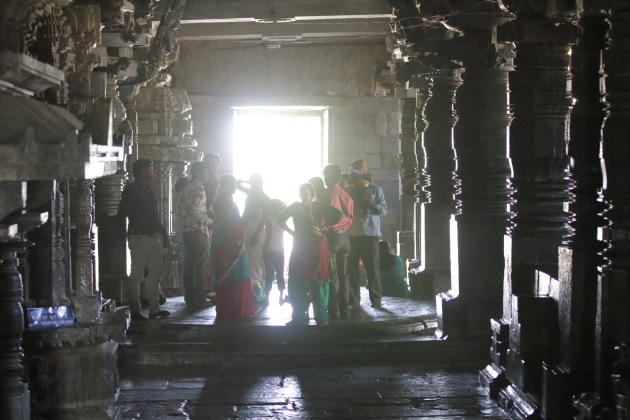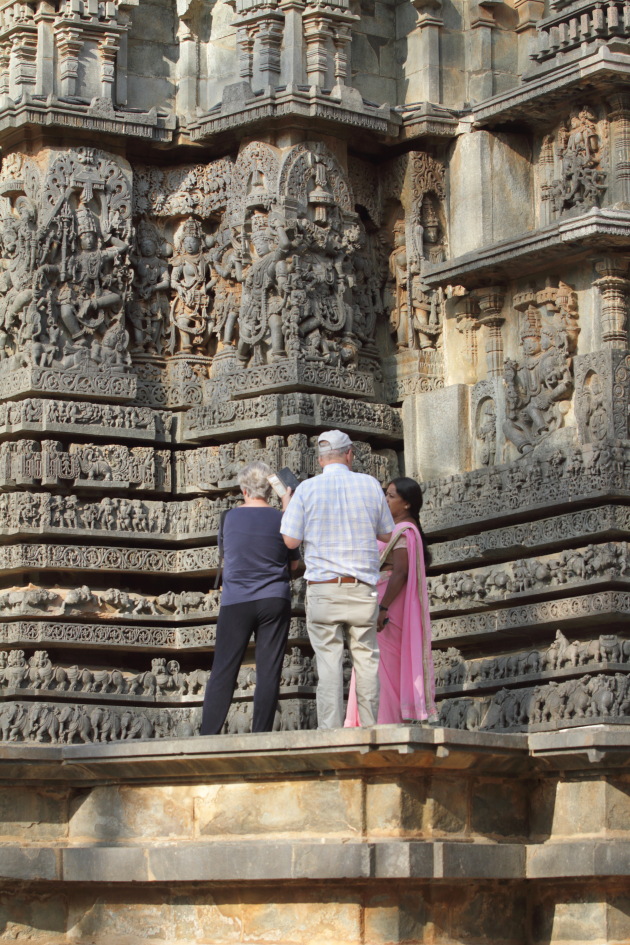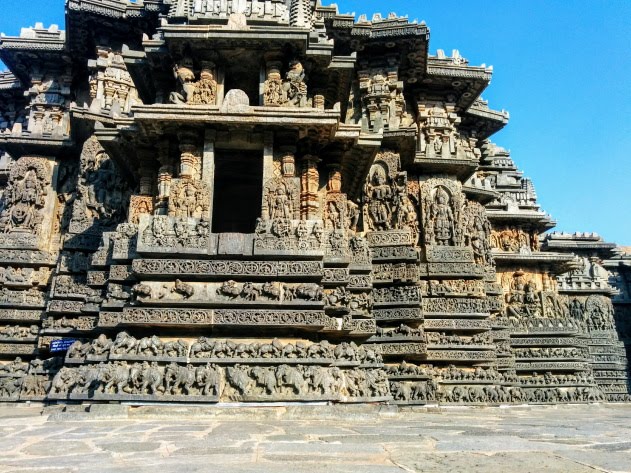Hoysala Sculpting Magic at Halebidu, Karnataka

Art, history and temple lovers will adore this place. It is small in size, but it packs a serious punch. From far away, it looks boring grey black, but up close, it unfolds stories of Hinduism from that era and that too with serious visual articulation. I am talking about the 12th century soapstone beauty of Hoysaleswara temple from Halebidu, the erstwhile regal capital of the famous Hoysala empire of Karnataka.

One of the largest temples dedicated to Lord Shiva in South India, it took about 30 years of painstaking sculpting before it took the form that we see today. It’s real beauty lies in the sculptures that run along the outer wall and in its doorways. Each of these sculptures portray a story from Hindu mythology that good knowledgeable guides can explain to you. The work is so intricate that you need to have a keen eye, lots of time at hand and oodles of patience just to cover a few feet of these sculptures. That is how much work that has gone into this articulate monument from a glorious era.

Even though the temple was sacked and damaged by Muslim invaders from northern India, the Hoysaleswara temple still stands tall to this day. When you touch these sculptures or even the smooth gigantic pillars inside the sanctum of the temple, you cannot stop yourself imagining how on earth the sculptors of 900 years ago managed such high levels of finish, polish and minute detailed carving without any of the modern machinery or some of the latest tools.

The Hoysaleswara temple is truly magnificent in every way. I have visited this temple 4 times in the past, the latest being as part of a Golden Chariot luxury train journey across Karnataka and every time I have stepped foot into the temple enclosure, my jaw drops. This temple is not about size, like say the monolithic statue of Baahubali at Shravanabelagola or about the big vihara work like most South Indian temples, but it is about the detailed work.

Like the Chennakeshava temple of Belur, the Hoysaleswara temple is built on a raised platform and the shrines inside have lathe turned pillared pathways, while the outer walls have storey like structure depicting various stories from that era. The raised platform is also star shaped on each of its corners, while the temple does not have any towers. The inner sanctum sanctorum dedicated to Lord Shiva is simple in structure and right opposite it is a beautifully polished Nandi made up of black granite. Standing tall and majestic, the Nandi is connected to the main sanctum through a small pathway.

Like everybody else, my favorite part of this temple are its step by step layered sculpting of the outer walls that start with the elephants, then the lions, then the stories of Ramayana and Mahabharata, then floral patterns and designs and finally the minute work of the Hindu deities. These Hindu deities could be the Sun god, Ganesha, Shiva Parvathi in seated position, Natarajar, the Tridev (Brahma, Vishnu and Shiva), the thousand head Raavana, Narasimha Avatar, Varaha Avatar and so much more.

As you can see from the pictures, this place is something truly special. It is definitely one of the top temple highlights of South India and certainly one of the gems of Karnataka. May be, you might want to include it into your itinerary of summer weekend getaways from Bangalore.

How to Reach Halebidu

Halebidu is about 16 kms from Belur, 31 kms from Hassan and about 230 kms from Bangalore by road. The nearest train station is at Hassan, which is well connected with the rest of the country. The nearest airport is Mysore, though better air connectivity can be found at Bangalore.

What else to see in the region
The Belur Chennakeshava temple, the off beat Doddagaddavalli temple, the Shettihalli rosary church ruins, the coffee estates of Chickmagalur, the Baahubali temple at Shravanabelagola or many other Hoysala temples spread all over this belt.

What to buy from here

The soapstone from this region is special and inexpensive. You could either buy atrefacts made out of soapstone as decorative pieces and gifts or buy yourself a nice stone based hand pounder for your kitchen.

Where to stay here

If you wish to stay close to the temple, you will need to make do with the simple guest houses and hotels at Belur and Halebid, but if you are mobile and don’t mind staying a bit away, the Hoysala Village resort just outside of Hassan or the homestays or luxury resorts near Chickmagalur make for grander and more comfortable stays.



































